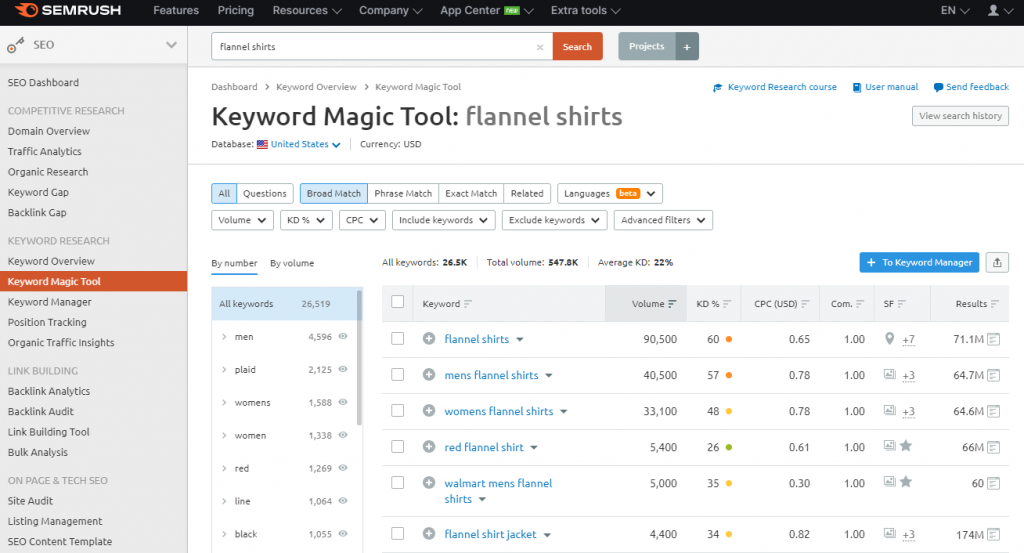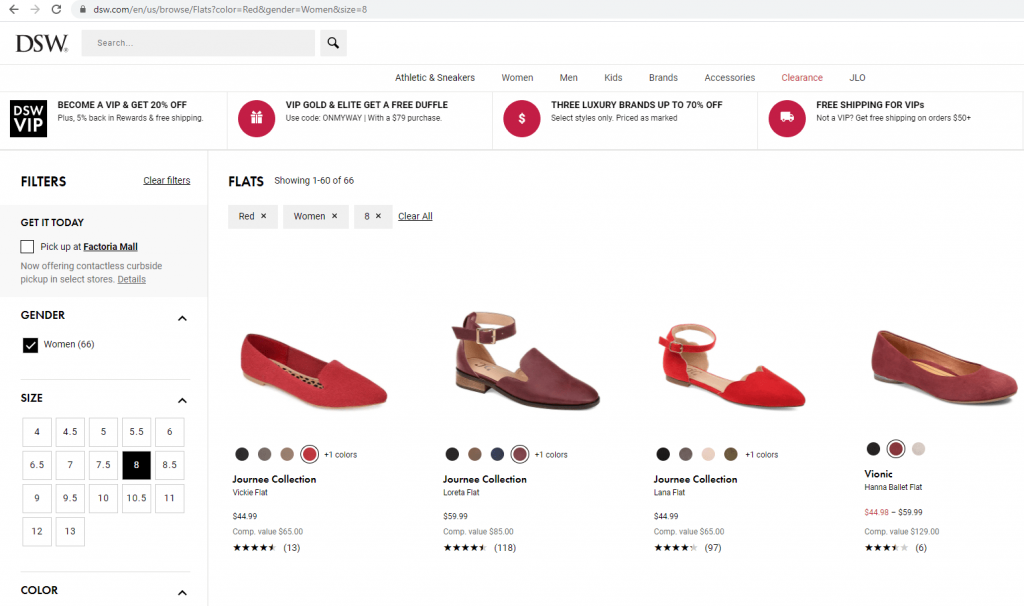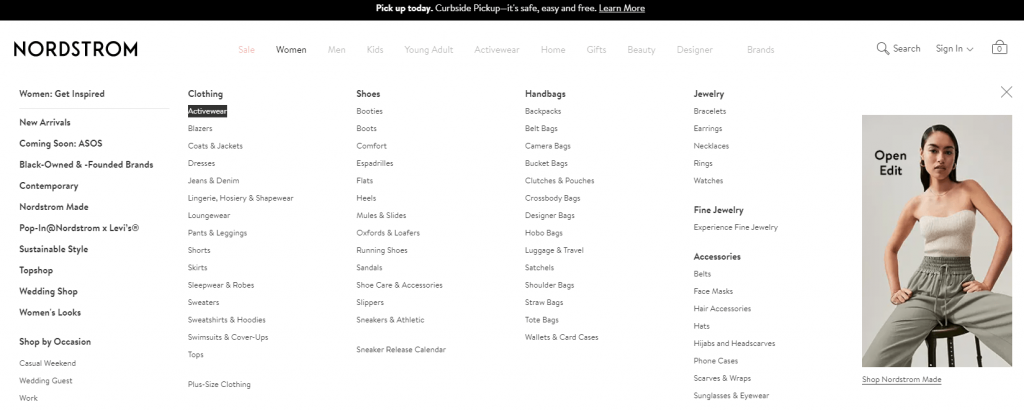What is faceted navigation, why is it important, and how can it throw your SEO off?
Faceted navigation is the feature on e-commerce sites where users have filter options to refine their product search. Depending on the type of product you could be looking at, you could have options to weed out products that aren’t of your preferred brand, size, color, etc.; for example, looking on a page that sells shoes, maybe you’d want to filter so you only see flats in size eight that are red.
When visitors are looking through your products, having the ability to filter out those that don’t fit their desired specifications is massively important if you sell more than a couple products as most e-commerce sites do. Otherwise you’ll end up with a bunch of frustrated people who abandon your site with no plans to return.
Screenshot of DSW shopping for red flats in size 8
But the reason why faceted navigation can cause problems for SEO is because of how each filter can create a unique indexable URL. This is what you see in the URL when you set a filter and notice specifications of [category]=[specification]. For example, searching for a women’s red shoe, you might see at the end of the URL something looking like “color=red&gender=women.”
This is an issue because more indexable URLs makes it harder for search engines to efficiently crawl your site, reducing your ranking potential.
Ways to work around faceted navigation SEO issues
Luckily, the user-friendliness of faceted navigation doesn’t have to doom your site’s SEO. There’s a handful of things you can do to improve your ranking potential while still using faceted navigation like, for starters, applying nofollow tags to the filter URLs. A nofollow tag essentially tells search engines to ignore that URL, rendering it with no impact on the website’s ranking. It will show up in the URL as rel=”nofollow.”
You can also apply the canonical tag to the filter URLs to specify the primary URL. “Canonical” pretty much means “preferred,” so this tag helps prevent duplicate content problems by specifying the preferred version of a URL.
Canonical and nofollow tags can seem a bit similar. The main difference is that nofollow tags don’t recycle ranking equity from inbound links, whereas canonical tags move ranking equity to the primary URL. For this reason, canonical can be better for ranking purposes since it’s kinda like a neon sign telling the crawler “Hey, don’t mind me, I’m just a part of that main URL over there,” but nofollows still have their value.
Considerations when implementing faceted navigation
First thing: There’s a difference between filters and categories! For example, on a clothing e-commerce site, they might have options for clothing, and under that umbrella the option for women’s clothing, and under that category there could be a further subcategory for activewear. That’s not the same thing as the faceted navigation filters that exist for the user to refine their choices within a category.
Screenshot of Nordstrom clothing categories
It’s also important to not get so carried away with creating the perfectly optimized site for search engines that it’s detrimental to the user experience. The reason faceted navigation is so ubiquitous is because, well-implemented, it makes a site infinitely more helpful and easy to navigate for visitors.
You want customers to be able to navigate the site easily and, from there, complete purchases easily. Part of this is making sure you don’t go overboard by offering an overwhelming amount of filters, or filters that aren’t really relevant.
Also, while you typically will be using many nofollow or canonical tags, there might be some longtail keywords you want to rank on — for example, a specific product or category of products — so make sure to not get overzealous with your noindex tags that would otherwise rob you of that longtail keyword ranking.
Faceted navigation and SEO best practices
The foundation of a good faceted navigation usage is having a clear understanding of the taxonomy of your products. Otherwise it’s way too easy to end up with a cluttered, less helpful set of filters and sub-filters.
In this same vein, you should avoid creating filters that already exist as categories. You want your filters to be comprehensive, not redundant; they should only be used to add granularity to categories that shouldn’t be split further.
There are also keyword tools like Google Trends, SEMRush, SPyfu, and others that can help you check the search volumes of product terms. These can be useful to decide how best to categorize your products. You’ll also want to enable site search in Google Analytics to see how people are searching within your site.

Screenshot of SEM Rush Keyword Research for flannel shirts
Lastly, as far as URL-related best practices, you should use hyphens instead of underscores in your site URLs; this is because hyphens are interpreted as spaces by Google, unlike underscores. We also recommend you put nofollow tags on both your sort option URLs and pagination URLs — i.e. where users can sort by different factors like “price: low to high” or “brand name,” and where users click to go to go the next page of items when there’s more items than can fit on one page.
In general, the good thing about faceted navigation is that it’s incredibly helpful for visitors to your e-commerce site while the problems it brings with it are quite solvable. It’s almost impossible to have a user-friendly e-commerce site without faceted navigation but, with just a simple bit of URL finagling, you can have both that user-friendly experience and your highest ranking potential to attract more future visitors.






